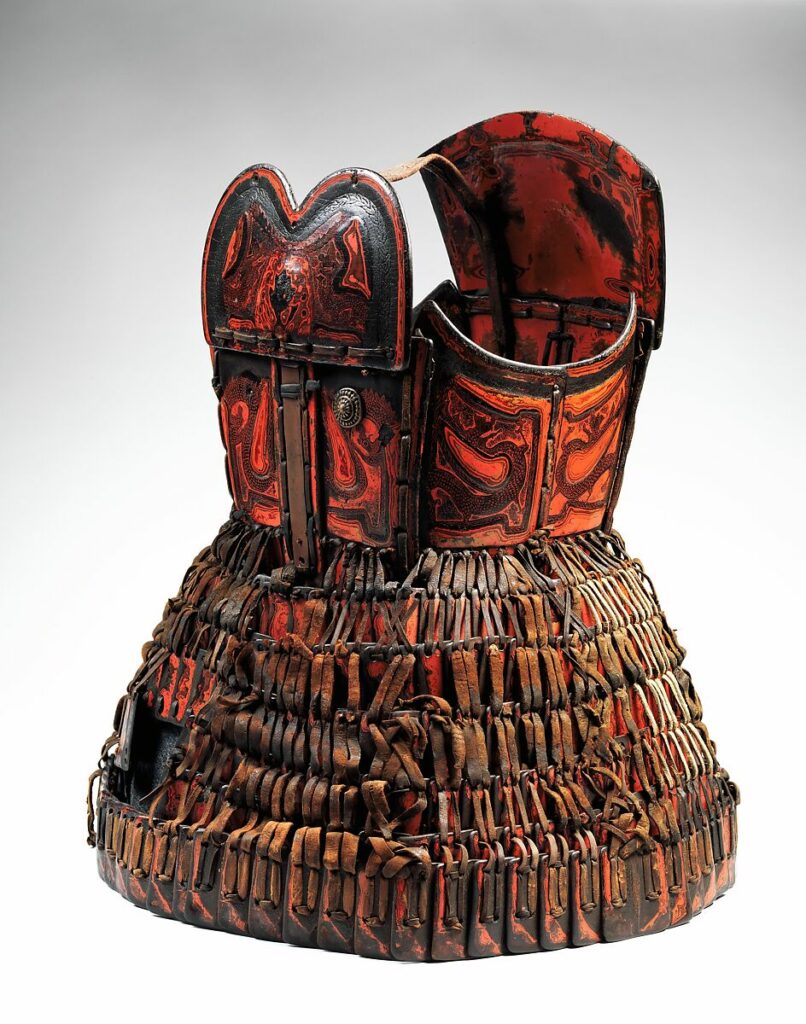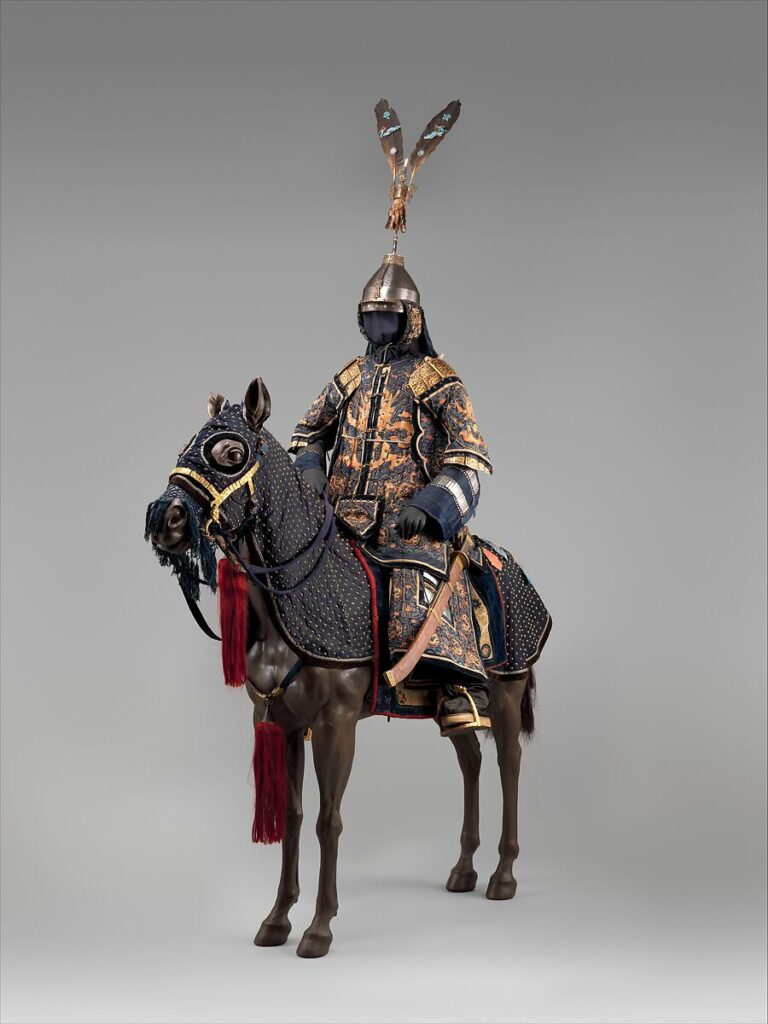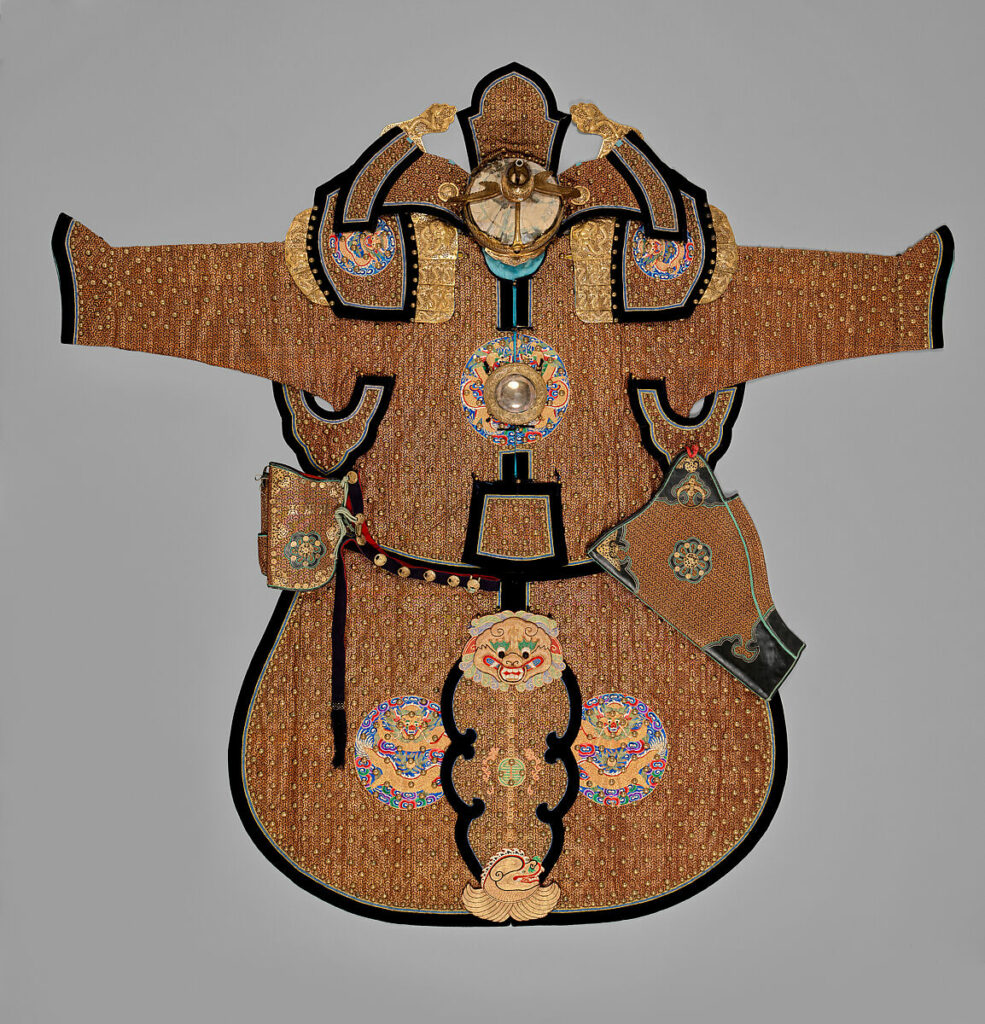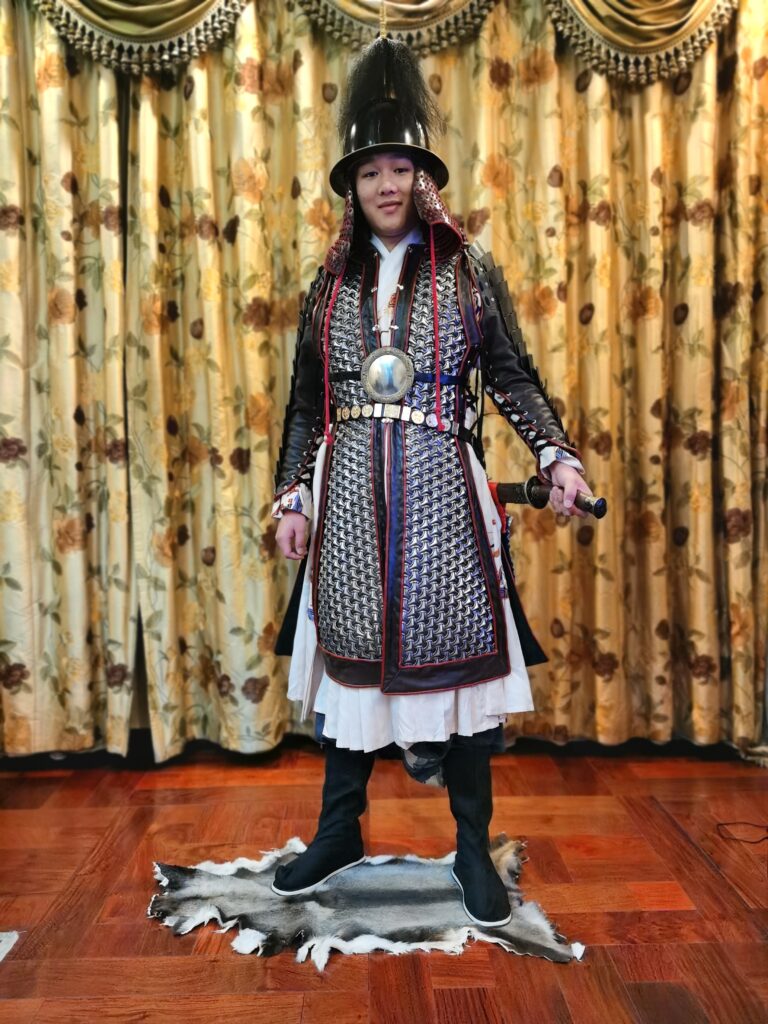
Amidst the chaos of battle and the clashing of steel, for a long history the Chinese armors stand not only as a testament to craftsmanship but also as a canvas with rich cultural symbolism. The armors from different ancient eras were more than just a line of defense between life and death, within their intricate designs and motifs lie signs of status and power, spiritual beliefs, and tales of cultural heritage. From the majestic dragon to the mysterious face of Taotie, each adorned the armors of a civilization’s history and pride.
Studying Chinese armors serves as a window to understand the multiethnic identity and heterogeneity of Chinese art and architecture. For the aesthetical designs of armors, signs of influences reflecting not only the dominant culture but also the diverse ethnic groups and regional traditions can be found, and to study how they have shaped the Chinese art represented in armors we can gain insights into the cultures and artistic expression. Furthermore, the knowledge gained from them may also help conduct cross-cultural comparison studies. Additionally, the journey does not pause as we entered the modern age. In the realm of contemporary recreation, there exists intersection where ancient symbolism meets modern interpretation. Through the modernization in craftsmanship and adaptation, it brings a new idea of a combination of tradition and innovation and gives Chinese armor, representing the history, a new form of life.
For this project, it involves the analysis and deciphering of the language of symbolism.
The main research question is “what symbolic meanings are embedded into the decorative motifs and designs found on Chinese armors” along with expanded research on how are the symbolic meanings of decorative motifs interpreted and adapted in contemporary recreation.
Chinese armor has a rich history spanning millennia, evolving with the military needs, social and cultural developments, and technological advancements. Historically, armors were, and for most parts have always been, a protective gear made from materials such as leather, clothes, and metal. Over time, as technology advanced and the needs became more sophisticated, such as the needs for better protection against more lethal weapons, armors underwent a variety of transformations in both design and function. Initially, armor mainly served the practical purpose of protecting soldiers from the dangers of battle. In addition to that, armor also functioned as a symbol of social status and display of martial powers. Lavishly decorated suits of armor were often worn by high-ranking military officials and aristocrats, symbolizing their elite status within the society. The craftsmanship and materials used in these prestigious armors, such as embroidered patterns and embedded jewelries, further conveyed the idea of wealth and power of the wearer their affiliation with the ruling elite. And because of that, armor designs often reflected cultural and regional identities at the time, with motifs and decorative elements drawing inspiration from diverse sources, including mythology, religion, natures, and more. These symbolic decorations give the armor deeper meanings beyond their primary function as protection, and reinforcing its connection to the cultural heritage and the idea of collective identity of its people.
Armor for the Torso and Hips

Title: Armor for the Torso and Hips
Date: 12th–13th century
Geography: Yunnan or Sichuan
Culture: Dali Kingdom (present-day Yunnan, China)
Medium: Leather, lacquer, copper alloy, iron
Dimensions: H. as mounted 24 in. (61 cm); W. 18 in. (45.7 cm); D. 18 in. (45.7 cm)
Credit Line: Purchase, Arthur Ochs Sulzberger Gift, 2014
Provenance: Metropolitan Museum of Art
This armor is one of only two early examples of this type known to exist. Its distinctive form and construction are unique to Yunnan province in southwestern China. Crafted from rigid leather panels coated with layers of vibrant red and black lacquer, this armor shows of an aura of sophistication and resilience. Upon closer inspection, the armor reveals its sophisticated symbolic motifs. The symbols of dragon/serpent can be seen on the larger panels on this armor. This is not a conventional dragon; it’s an adaptation of the iconic Chinese dragon, bearing the unique characteristics of the serpent. This fusion reflects the regional culture of Yunnan in contrast to the dominant Han culture at the time. This version of the dragon pattern in combination with the sun medals are unique to the local culture in Yunnan.
What makes this armor remarkable and important to the research is its localization within the context of Yunnan’s cultural landscape. While dragons are iconic in Chinese mythology, the interpretation of it, coupled with the adaptation of Yunnan’s serpent motifs and the sun medals, speaks to the unique culture of Yunnan. This shows how tradition intersects with innovation. Also, their appearance on an armor belonged to the far southwest corner on ancient China shows the dragon as a mythical creature was universal and commonly idolized in China, and to some extent reinforces the idea of a form of unified multiethnic identity.
Ceremonial Armors for Man (Dingjia) and Horse

Figure 2. Ceremonial Armors for Man (Dingjia) and Horse. Armor. Metropolitan Museum of Art, New York. Accession # 36.25.2a–qq. https://www.metmuseum.org/art/collection/search/24010
Title: Ceremonial Armors for Man (Dingjia) and Horse
Date: 18th century
Culture: Qing Dynasty, China
Medium: Steel, gold, silver, velvet, satin, iron, coral, malachite, turquoise, crystal, silk, cotton, brass, pearls, marten, feathers (kingfisher, Golden eagle), paper, lacquer
Dimensions: Helmet (a); H. including nape defense 19 in. (48.3 cm); H. excluding nape defense 11 1/2 in. (29.2 cm); W. 8 3/16 in. (20.8 cm); D. 9 3/4 in. (24.8 cm); Wt. 3 lbs. 11.8 oz. (1695.3 g); helmet lining (b); Wt. 2.8 oz. (79.4 g)
Credit Line: Bequest of George C. Stone, 1935
Provenance: Metropolitan Museum of Art
The man’s armor, known as dingjia or “armor with nails”, stands as an elaborate example of the military attire worn at the imperial court worn by high-ranking officials in the Qing empire. Unlike the utilitarian armors worn in battle, this is a ceremonial armor, meaning it’s used during ceremonies instead of common warfare. During battles, the high-ranked officer would wear another more practical armor on top of it should he charge into the enemies with his soldiers.
The jacket, adorned with armored sleeves and a lap skirt, is luxuriously decorated with complex patterns of dragons, waves, and clouds. The gilt steel plates on the helmet and shoulders also repeat those motifs. The dragon is perhaps the most iconic motif in Chinese armor design. It symbolized imperial power, strength, and good fortune, which to some extent is greatly needed in battles. Usually, those patterns wouldn’t appear on common soldiers’ armors, because they also represent rank, social status, and royal prerogative. Similarly, the helmet and the crest (the decorative part on top of the helmet), are also delicately engraved and decorated with said motifs. They are rendered in gilt steel plates, creating a harmonious visual narrative that speaks to the wearer’s exalted position among the people they command. Also, the intricacy of the engraving and the delicate application of gems and enamels further accentuate the armor’s luxurious appeal. Although the use of gems and enamels on armors were not rare throughout Chinese history, they were more commonly in the later dynasties. In summary, as a testament to the intersection of artistry and martial tradition, this Dingjia serves not only as a symbol of might but also a work of art showcasing the richness of cultures.
Painted banner of Tian Wang

Figure 3. Painted banner of Tian Wang. Painting. 16 x 6.1 in. The British Museum, London. Accession # 1919,0101,0.129. https://www.britishmuseum.org/collection/object/A_1919-0101-0-129
Title: Painted banner of Tian Wang
Date: 9th century
Geography: Mogao Cave #17, Dunhuang, China
Culture: Tang Dynasty, China
Medium: Silk and paints (ink)
Dimensions: H. 16 in. (40.5 cm); W. 6.1 in. (15.5 cm);
Credit Line: Field Collection by Sir Marc Aurel Stein, 1919
Provenance: The British Museum, London
This is a painted banner depicting Tian Wang (Heavenly King), the Guardian of the East. Tian Wang is a mythological general figure in Buddhism in China, he embodies the virtues and protective qualities revered within the tradition, serving as a stalwart guardian of the faith. As the Tian Wang being depicted as a general, it shows the infusion of Buddhism and traditional Chinese military ideology. Clad in magnificent armor, armed with a bow, and standing on a demon alike creature, Tian Wang stands as an authority and strength embodiment.
The tiger skin draped around his waist is a noteworthy detail. Tigers, because of their predatorial features in nature, are often associated with characteristics such as ferocity, martial valor, strength, and intimidation. Using a tiger skin to decorate the armor suggests his power over one of the most lethal apex predators of nature. Arguably, it is more of a trophy to boast instead of a practical additional piece for the purpose of defense. Regardless, this motif certainly adds to the visual splendor of the already decorated armor with traditional beliefs regarding the qualities of animal. Moreover, the most interesting element in this painting is perhaps the “tiger-like creature’s face” on his waist. It is unknown if this is directly associated with the ancient mythology creature, Taotie, but to some extent it offers a glimpse into the cultural inheritance of symbolic adornment that can be traced back to the earliest days of Chinese civilization. Taotie is one of the most prominent motifs in ancient Chinese art and mythology, primarily seen on artifacts from the Shang and Zhou dynasties, the earliest dynasties in Chinese history. Originally, Taotie was a gluttonous creature that’d devour everything it can. Because of the insatiable greed and appetite it represents, ancient people, especially the rulers and elites, viewed Taotie as a symbol of protection, to “eat” all the evils, and a reminder of the perils of excess, the potential risks and dangers of being too greedy, at the same time. This complex nature of the Taotie influenced the philosophy, reminding people the importance of balance and caution while encouraging them to thrive and to fight for what they eager. Therefore it’s not uncommon to see the symbol and representation of Taotie appear on armors, which are directly related to warfare. Over time, the Taotie motif underwent stylistic variations and adaptations, many of the representations of Taotie, if they were, changed greatly so it’s not to identify them in a contemporary sense without the support of historical texts. Whether this face on Tian Wang’s waist belongs to Taotie or not, it contributes to the diversity of use of motifs on armors in ancient China regardless.
Armor with Archery Equipment and Box

Figure 4. Armor with Archery Equipment and Box. Armor. Metropolitan Museum of Art, New York. Accession # 36.25.4a–t. https://www.metmuseum.org/art/collection/search/105347
Title: Armor with Archery Equipment and Box
Date: ca. 1840
Culture: Chinese
Medium: Textile (silk), copper alloy, steel, gold, silver, wood, leather, lacquer, paper, pigment
Classification: Armor for Man
Credit Line: Bequest of George C. Stone, 1935
Provenance: Metropolitan Museum of Art
Accession Number: 36.25.4a–t
This cloth armor is made primarily with textile of silk with application of metal to reinforce sever areas around the shoulders and chest. Similar to figure 2, the Dingjia, it can be inferred that it is a ritual armor rather than a practical armor for battle. Besides the reappeared dragon motifs along side with other patterns, its most interesting element is the triangular patterns, known as the Mountain scale pattern or Shanwen, swen onto the clothes. In many earlier theories and popular opinions, Mountain scale pattern armors were thought to be a type of chainmail armors whereas the triangular metal pieces were linked together in the same principle of how chainmail armors work. Because there are no surviving examples excavated, the accuracy and reliability of this theory has been questioned to varying degrees. There are paintings and statues depicting this type of patterns on armor, however it appears it’s likely a misinterpretation. Rather than being a type of chainmail as commonly assumed, it appears that the Mountain scale pattern was intended as a decorative motif, meticulously woven into the fabric of garments to enhance their visual appeal and symbolic significance as showed in figure 4. This revelation challenges conventional understandings of ancient armor design and highlights the dynamic nature of historical interpretation. The Mountain scale pattern itself, if its true appearance is what’s shown on this particular armor, serves more as a showcase of craftsmanship. Undeniably, the absence of surviving examples may hinder the researches, but it does shine lights on the methods could be taken.
Ming Styled Armor (Ming Jia / Ming Kai) Replica

Figure 5. Ming Styled Armor (Ming Jia / Ming Kai) Replica. Armor. 55 x 60 in. Simon Song’s home, Beijing. Made by Simon Song. No accession number.
Title: Ming Styled Armor (Ming Jia / Ming Kai) Replica
Date: July, 2020
Culture: Ming Dynasty, China
Medium: Steel, clothes, leather.
Dimensions: Approximately 140cm(55in. ) L., 60cm(24in.) W.
Maker: Simon Song
Provenance: My home, Beijing, China
This armor made by me is a replica based on the Ming dynasty armor design, which is called Ming Jia/Ming Kai. A typical Ming styled armor is a combination of cloth armor and chainmail armor. This design, in theory, is versatile and practical on the battlefield. The qualities of cloths, flexible and suitable for mass production, and the qualities of metal chainmail, durable and effective in close quarter combats, made the Ming styled armors effective in its time. The front and back panels of the Ming Jia are fortified with chainmail, providing coverage to vital areas of the torso while maintaining flexibility and mobility. Metal plates adorn the shoulders and arms, offering additional protection against slashing and piercing attacks, without compromising agility. In instances where heightened defense is required, leather reinforcements and additional plates are integrated into the armor, further fortifying its protective capabilities. As for the sleeves, the cloths I chose to work with has the dragon motifs on them. In reality, that pattern would not appear on a common soldier’s armor because of traditions and the strict rules between different social classes. However, I did so regardless because in modern days dragon is viewed as a universal cultural symbol for Chinese people. What was one belonged to the privileged elites is now accessible to every individual in the society and can be celebratedly claimed for the purpose of a sense of cultural identity. While I was making this replica, I didn’t aim for historical accuracy to recreate follow the style exactly. Instead, I approached the project with modern methods, such as using actual mass produced “Mountain scales” to build the chainmail. What could be deemed unachievable by the technology and standards of the past, such as creating these intricate metal pieces and chaining them together to form functional armor, can now be realized with relative ease. To some extent, this shift in perspective made me reconsider the ingenuity and resourcefulness of our ancestors while also encouraged to innovate what is traditional. By embracing new materials, techniques, and aesthetics, hobbyists and artisans today have the freedom to reinterpret and reinvent, bringing new life into age-old traditions while ensuring their relevance and cultural heritage. In this sense, the “misinterpretation” of the Mountain scale pattern could be viewed as a reinterpretation instead. It reminds us that tradition is not stagnant but rather can be fluid and continues to evolve and flourish in a contemporary sense.
The article “The Taotie Reconsidered: Meanings and Functions of the Shang Theriomorphic Imagery” by Kesner offers a comprehensive exploration of the symbolic significance and cultural functions of the Taotie motif in Shang Dynasty art. The author analyses and even challenges some of the conventional interpretations of Taotie as a decorative motif through an analysis of archaeological findings and textural sources. This article provided essential information needed to better understand Taotie as a cultural symbol in ancient China. In “The Animal in Shang and Chou Bronze Art” by K. C. Chang, the author examines the significance of animal imagery in the bronze art of the Shang and Zhou dynasties. Chang selected and cross-references the diverse motifs and the roles they played in Shang and Zhou society, ranging from religious symbolism and ritual sacrifice to social hierarchy and political power. The insights into the rich tapestry of beliefs, values, and artistic expressions are essential to my interpretation and analysis on the motifs on armors.
During the journey of my research, several themes emerge, each resonating with broader questions of cultural identity, technological progress, and artistic interpretation. The revelation of the Mountain scale pattern’s true nature challenges us to reconsider preconceived notions and embrace the dynamism of historical interpretation. Likewise, the evolution of armor design—from the Ming Jia’s innovative blend of materials to the reinterpretation of ancient motifs—reminds us of the enduring legacy of tradition and the transformative power of adaptation.
Bibliography
“Armor for the Torso and Hips”, The Metropolitan Museum of Art, accessed March 2, 2024, https://www.metmuseum.org/art/collection/search/658575
“Armor with Archery Equipment and Box: Chinese.” The Metropolitan Museum of Art, www.metmuseum.org/art/collection/search/105347. Accessed 7 May 2024.
Bullock, Randolph. “Oriental Arms and Armor.” The Metropolitan Museum of Art Bulletin 5, no. 6 (1947): 169–71. https://doi.org/10.2307/3258117.
“Ceremonial Armors for Man (Dingjia) and Horse: Chinese,” The Metropolitan Museum of Art, accessed March 2, 2024, www.metmuseum.org/art/collection/search/24010.
Chang, K. C. “The Animal in Shang and Chou Bronze Art.” Harvard Journal of Asiatic Studies 41, no. 2 (1981): 527–54. https://doi.org/10.2307/2719054.
Dien, Albert E. “ARMOR AND WEAPONS.” In Six Dynasties Civilization, 331–38. Yale University Press, 2007. http://www.jstor.org/stable/j.ctt5vm2b9.15.
Dien, Albert E. “A Study of Early Chinese Armor.” Artibus Asiae 43, no. 1/2 (1981): 5–66. https://doi.org/10.2307/3249826.
Kesner, Ladislav. “The Taotie Reconsidered: Meanings and Functions of the Shang Theriomorphic Imagery.” Artibus Asiae 51, no. 1/2 (1991): 29–53. https://doi.org/10.2307/3249675.